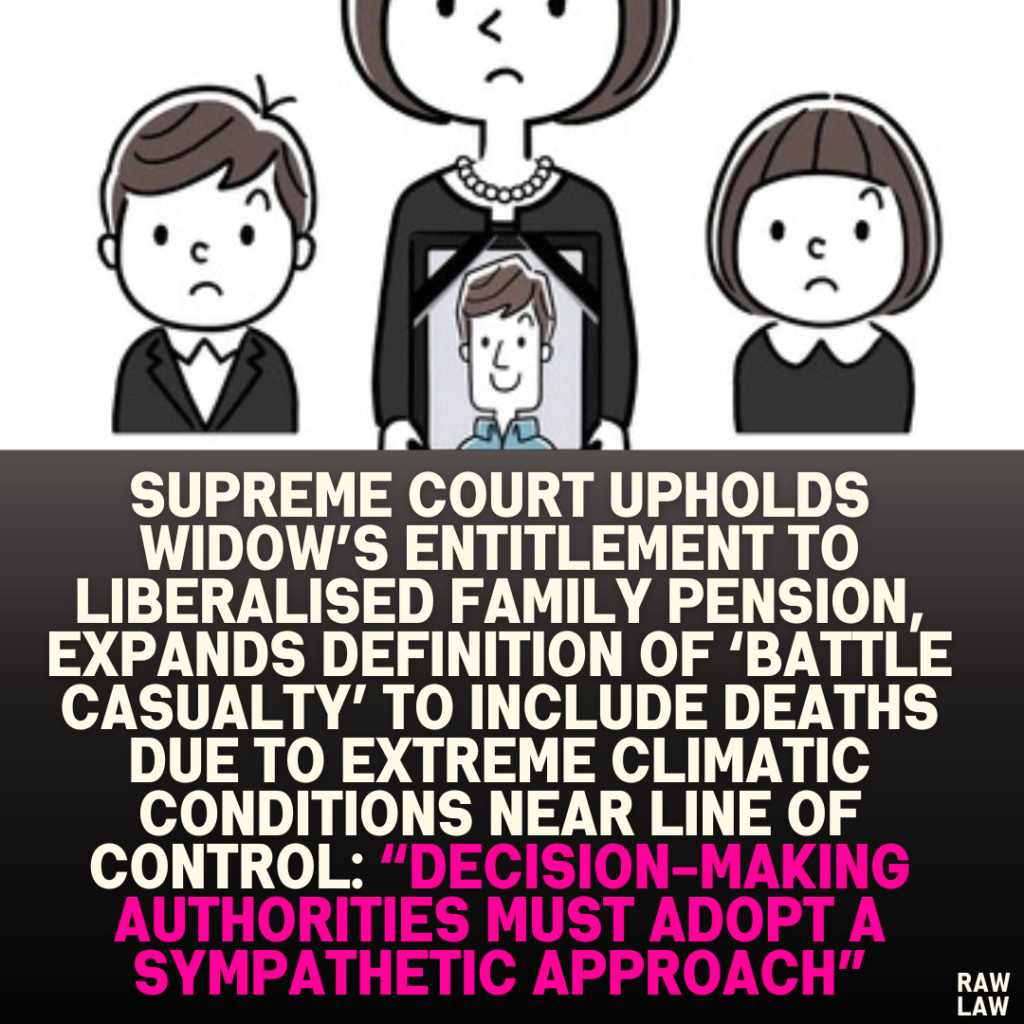1. Court’s Decision:
The Supreme Court dismissed the appeal filed by the Union of India, affirming the Armed Forces Tribunal’s judgment. The Court ruled that the soldier’s death qualified as a “battle casualty” under the Ministry of Defence’s guidelines and Army Order 1 of 2003. Consequently, the Court upheld the widow’s entitlement to the Liberalised Family Pension (LFP) and directed the appellants to implement the Tribunal’s judgment within three months. Additionally, costs of ₹50,000 were imposed on the Union of India for unnecessary litigation.
2. Facts:
- The deceased soldier served in the Indian Army and was deployed near the Line of Control (LC) as part of Operation Rakshak.
- On January 23, 2013, while conducting an Area Domination Patrol in extreme climatic conditions, the soldier experienced breathlessness during duty from 1:00 AM to 3:30 AM.
- Despite efforts to evacuate him, bad weather prevented air evacuation. He was moved on foot to the medical post but succumbed to cardiopulmonary arrest before reaching adequate medical facilities.
- Initially classified as a “battle casualty” by the Commanding Officer, his death was later reclassified as a “physical casualty,” causing the widow to be denied the Liberalised Family Pension (LFP).
- The widow approached the Armed Forces Tribunal, which ruled in her favor, directing the grant of LFP and associated benefits.
3. Issues:
- Whether the soldier’s death qualified as a “battle casualty” under relevant Army Orders and Ministry of Defence guidelines.
- Whether the widow was entitled to LFP under Category E, Clause (f), of the Ministry of Defence order dated January 31, 2001.
4. Petitioner’s Arguments (Union of India):
- The death was classified as a “physical casualty,” not a “battle casualty.”
- The conditions for granting LFP under Category E were not satisfied since the death was not caused by “war-like situations.”
- The Tribunal’s decision was erroneous and contrary to previous judgments (Kanchan Dua and Radhika Devi).
5. Respondent’s Arguments (Widow):
- The deceased was on active duty near the LC under extreme climatic conditions, fulfilling the criteria for a “battle casualty.”
- The initial classification of “battle casualty” by the Commanding Officer was correct and supported by the circumstances.
- The denial of LFP due to reclassification to “physical casualty” was arbitrary and unjust.
6. Analysis of the Law:
The Court examined:
- Ministry of Defence Order (January 31, 2001):
- Clause 6.1: Specifies that LFP is granted for deaths classified under Categories D and E. Category E includes deaths caused by “war-like situations.”
- Army Order 1 of 2003 (Appendix A):
- Clause 1(g): Categorizes deaths due to illness caused by extreme climatic conditions while operating near the LC as “battle casualties.”
The Court observed:
- The deceased was part of an Area Domination Patrol near the LC in extreme climatic conditions, qualifying as a “battle casualty” under Clause 1(g).
- The death also fell under Category E, Clause (f) of the Ministry of Defence order, as it resulted from a “war-like situation.”
7. Precedent Analysis:
The Court distinguished this case from the judgments cited by the appellants:
- Kanchan Dua v. Union of India:
- The soldier was found dead in his room, unrelated to operational duties.
- Radhika Devi v. Union of India:
- Death occurred without extreme climatic conditions or operational context.
The Court clarified that these cases involved different factual circumstances and were not applicable here.
8. Court’s Reasoning:
The Court reasoned:
- The soldier’s death was caused by extreme climatic conditions while on duty near the LC under Operation Rakshak, making it a “battle casualty” under Clause 1(g) of Appendix A.
- Category E, Clause (f) of the Ministry of Defence order has an inclusive definition of “war-like situations.” The soldier’s deployment near the LC under extreme conditions fell within this scope.
- The appellants’ decision to reclassify the death as a “physical casualty” and deny LFP was arbitrary and lacked justification.
- The appellants failed to adopt a sympathetic approach in handling the widow’s claim, compelling her to litigate unnecessarily.
The Court emphasized:
“In a case like this, the respondent ought not to have been dragged to this Court. The decision-making authority ought to have been sympathetic to the widow of a deceased soldier who died in harness.”
9. Conclusion:
- The appeal by the Union of India was dismissed.
- The Court upheld the Tribunal’s direction to grant the widow LFP and associated benefits, to be implemented within three months.
- The Union of India was ordered to pay costs of ₹50,000 to the widow within two months.
10. Implications:
- Liberal Interpretation of ‘Battle Casualty’:
- Expands the definition to include deaths caused by extreme climatic conditions near operational zones.
- Sympathetic Approach in Military Claims:
- Underscores the duty of decision-makers to consider the hardships faced by the families of deceased soldiers.
- Precedent for Future Cases:
- Sets a benchmark for resolving disputes involving the classification of casualties and associated benefits.
